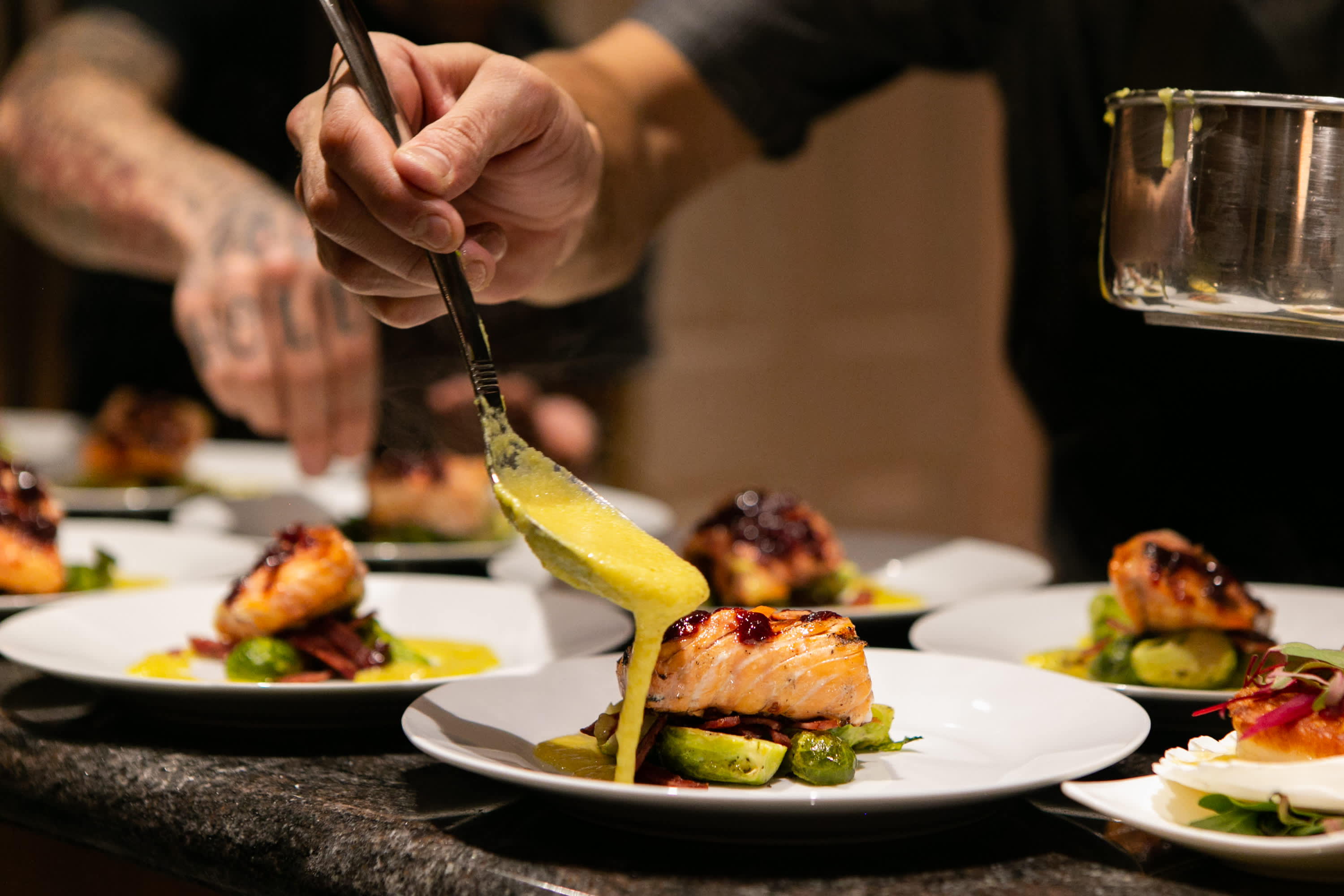Pandemic accelerated an already booming market for personal chefs

Chefs applying sauces and garnishes to a salmon entrée at a client’s home.
Source: Christine Hyatt
The personal chef business is booming as more consumers choose to eat at home during the coronavirus pandemic, rather than at restaurants.
The virus is expected to cause the restaurant industry to lose $240 billion in sales this year, based on estimates from the National Restaurant Association. Lockdowns pushed many Americans to spend more time eating at home, whether it’s restaurant food delivery, at-home cooking or the fruit of a personal chef’s labor.
“It’s unfortunate that Covid-19 has brought what we do to the surface, but I’m starting to see a lot of people who are looking at the personal chef and in-home dining experience as a great alternative to the dining experience as of now,” said Brian Driscoll, co-founder of the Glendale, Arizona-based personal chef company Driscoll Cuisine & Cocktail Concepts.
The United States Personal Chef Association estimates that there are between 5,000 and 6,000 personal chefs working nationwide. Personal chefs own their businesses, unlike private chefs, who are employees of a particular household.
According to Angela Prather, membership and partnership manager of the trade group, the personal chef industry started decades ago because of demand for outsourcing meal preparation. But special occasions have become a part of the business as well, and some — including Driscoll Cuisine — have opted to focus most of their efforts on attracting those customers.
The pandemic hit as the industry was in the middle of a boom, according to Prather, and has further accelerated the trend.
When restaurants began reopening for indoor and outdoor dining across the country, many consumers still felt uncomfortable partaking, particularly if they had underlying health conditions. While diners might know and trust the members of their party, they don’t know who occupies neighboring tables. The Centers for Disease Control and Prevention has linked dining out to a higher risk of contracting Covid-19, although the National Restaurant Association has disputed the findings.
Moreover, the experience of going to a restaurant today is vastly different from that at the same time last year. Menus are pared down, wait staff wear masks and dining with a party larger than six people may be illegal.
For consumers looking to celebrate anniversaries or birthdays, a meal from a personal chef can help make up for the disappointment of missing out on typical festivities. For example, brides and grooms who moved their weddings to Zoom and canceled their wedding receptions have decided to celebrate with more intimate dinners prepared by a personal chef with close family members instead.
Co-founders Monique Hayward and Brian Driscoll
Source: Christine Hyatt
“We’ve got a lot of pent-up demand because everyone lost Easter, Mother’s Day, graduations — all of those occasions,” Driscoll Cuisine co-founder Monique Hayward said.
But not all personal chefs have been seeing such a surge in sales. Personal chef Katie Simmons has owned her own Chicago-based business for eight years and specializes in cooking for busy families or people with dietary restrictions.
When the pandemic first hit, Simmons’ business was slashed in half.
“People were really watching their budget, and they were home and more inspired to cook,” she said.
But in the last two or three months, demand has returned, particularly from consumers looking to eat with their own health in mind. Simmons said that she’s seen much more interest in at-home dinner parties, but she’s had to turn down the requests because she lives with someone who is at higher risk for complications from Covid-19.
The pandemic has also triggered an economic crisis, with the unemployment rate in September hitting 7.9% and the U.S. gross domestic product plummeting 31.4% from April through June.
For some consumers, that may mean a personal chef is out of their budget, but Hayward said that the cost of a personal chef is similar to the same experience at a restaurant. For example, a five-course dinner with wine pairings created by one of her company’s chefs will cost about $250 per person, including services and fees.
“People who are already disposed to spending this kind of money on this kind of experience are already a bit recession-proof,” Hayward said. “We’re not generally seeing people in our target market and demographic who are concerned about cost, per se. It’s been mainly the pandemic that’s scaring people.”
The personal chefs who are enjoying a lift in sales now might soon find more competition for their customers. Mounting restaurant closures mean a deluge of out-of-work chefs. The Bureau of Labor Statistics estimates that there were 128,190 chefs and head cooks working in the U.S. last year, and employment in food services and drinking places has plummeted by 2.3 million since February.
“I’m the membership manager, and I have definitely seen a great deal of interest from what we call brick-and-mortar chefs,” Prather said, adding that the trend started before the crisis, thanks to the more flexible hours and higher quality of life.




